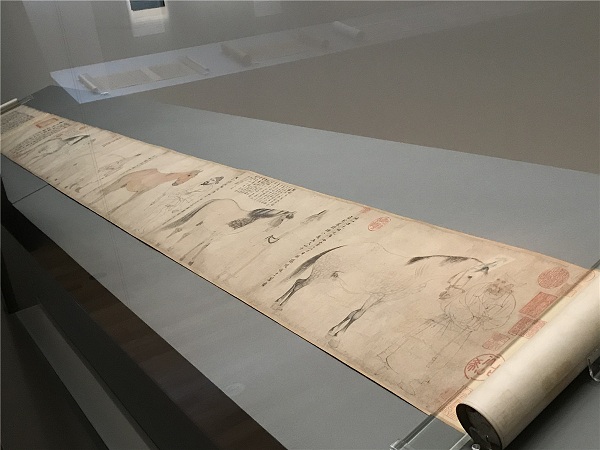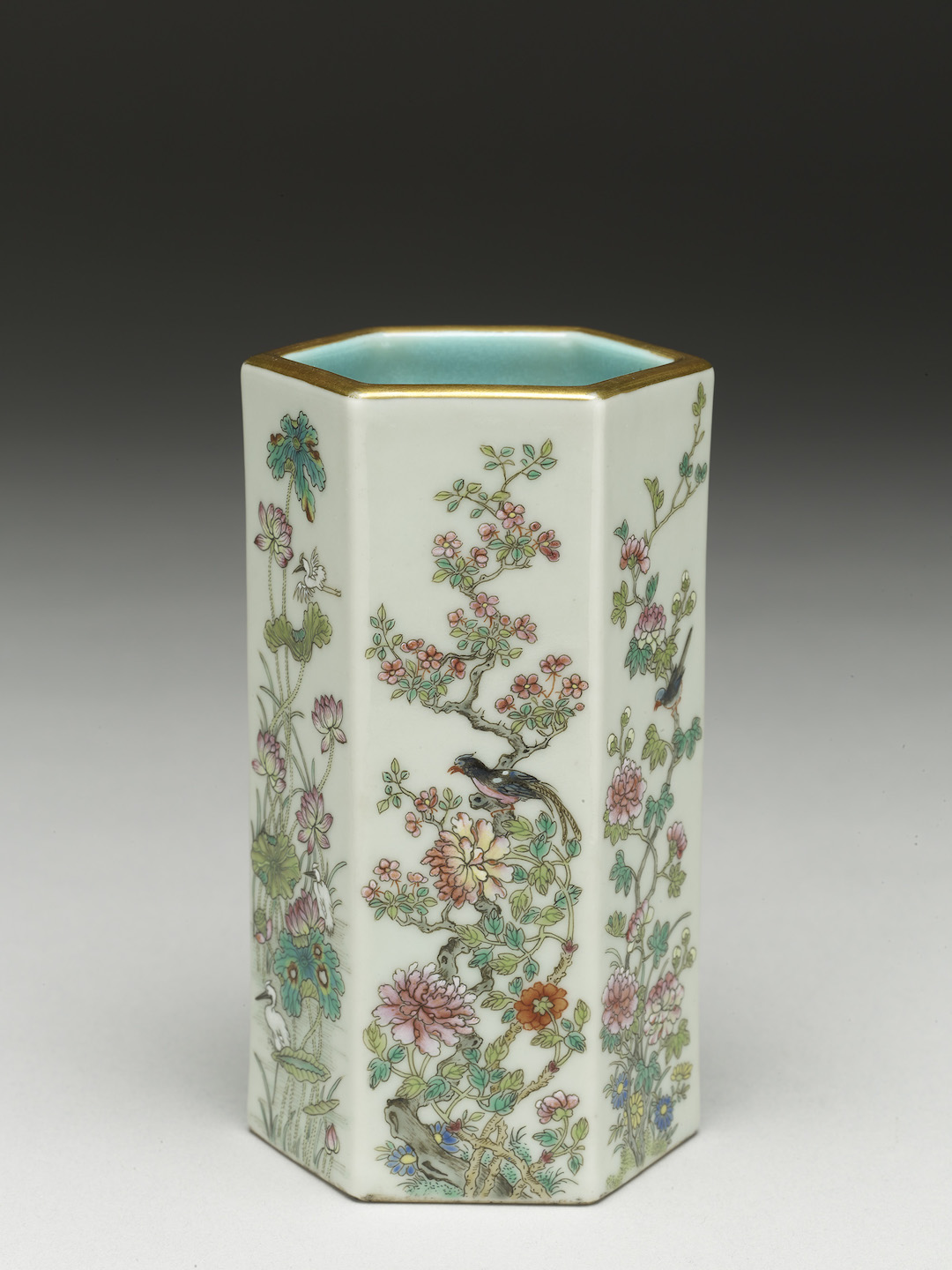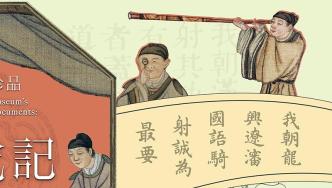
Studying hard in the cold window seems to be a portrayal of the life of many students in ancient and modern times studying hard. However, in the Qing Dynasty, the children of the Manchu royal family who grew up in the palace and were born with silver spoons in their mouths also needed to receive strict civil and military education. According to the literature records, elder brother's study room is only closed for five days regardless of the winter or summer. The Paper learned that the National Palace Museum in Taipei recently launched a new exhibition - "Treasures of Qing Dynasty Historical Documents in the Collection: The Story of Elder Brother's Development". "Three units, through the collection of documents and archives, lead the audience to explore the true appearance of the elder brother's study and life in the Qing Dynasty.
"Age" is the Qing Dynasty's name for the children of the near branch clan. After the Manchus took over the Central Plains, influenced by Confucian culture, they began to attach importance to the education of elder brothers, so as to train future heirs to the throne and talents in state governance, so that the Manchu regime could be consolidated for a long time.
According to the records of the Qing Dynasty, since the age of six, Elder Brother entered the study every morning at 3 o'clock in the morning. In addition to the classics such as the Four Books and Five Classics that folk scholars must read, he also had to take the Manchurian "Mandarin Riding and Archery" course. Mandarin is Manchu, and riding archery is horseback archery. The Qing Dynasty paid special attention to learning the skills of the clan's children traveling outside the customs and hunting. As the Qing royal family came into contact with the West, the elder brothers also added courses such as astronomy, mathematics and science to understand the world situation outside China.
Brothers' homework lists emphasize the integration of literature and martial arts, and mix Chinese and Western sciences. It is different from the emphasis on liberal arts in previous Chinese dynasties, but it seems to be comparable to the diverse learning fields of today's school-age education. Although brothers do not need to take the science test, they do not have the pressure of competition for higher education among students nowadays. However, according to the literature records, elder brother's study room is only closed for five days, regardless of the winter or summer, and his studies are not unreasonable. The exhibition tries to unravel the mystery of the education of the princes of Manchuria, see the similarities and differences of the students' hard work, and provide new cognition and possibility for the current education.
Brother goes to school
Qianlong (1711-1799) went to school at the age of six. At the age of twelve, he first met his ancestor Emperor Kangxi (1654-1722) at the Peony Terrace in the Old Summer Palace. He won the emperor's heart and was taken into the palace to cultivate carefully, and became the heir to the throne in the future. Emperor Qianlong was proficient in all kinds of civil and military skills, and wrote more than 40,000 poems in his life, which can be described as profound learning. It also makes people wonder, what kind of education did the children of the Manchu clan who grew up in deep palaces or noble mansions receive?
In the Qing Dynasty, the Shang Shufang (or Shang Shufang, A Ge Study Room) system was first established during the Yongzheng period, and it was the place where A Ge went to school. My elder brother studied from the age of six to fifteen, which is equivalent to today's primary school to middle school. Even if he has been ennobled as a prince or Baylor, he still has to go to the study room to study. Every morning Yinshi (3-5am) enters the study, first learns to draw the bow, learns Manchu and Mongolian; then starts to study Chinese classics from Maoshi (5-7am) until the end of school in the evening. After school, I practice riding and shooting, recite Manchu and Mongolian Chinese, review Chinese, etc., and my study life is fulfilling and compact.
During the year, holidays are only allowed on New Year's Day, Dragon Boat Festival, Mid-Autumn Festival, Wanshou Festival and my brother's birthday. No classes are allowed regardless of whether it is cold or hot. In addition to the upper study room in the palace, the elder brother's classes were held in the South Study Room, Yuqing Palace and Maoqin Palace. Outside the palace were the Old Summer Palace and the Summer Resort. There is an archery field next to the study, and there is an "Arrow Pavilion" in the Forbidden Palace. As for the vast Royal Mulan Paddock, it is a key area for training brothers in riding and shooting.

"Yangji Zhai Conglu" Volume 4 (Volume 2) written by Wu Zhenfeng of the Qing Dynasty, published by the Wu family in Qiantang in the 22nd year of Guangxu's reign in the Qing Dynasty, collected by the National Palace Museum in Taipei
Today, people want to know the age, schedule and study content of my elder brother when he entered the study room. We can see the notes and miscellaneous notes from the Qing Dynasty. According to the "Yangjizhai Conglu" (Volume 4) written by Wu Zhenzhen (1792-1870) during the Daoguang and Xianfeng years of the Qing Dynasty: "The prince and grandson of my family law studied at my grandfather when they were six years old. time) to the study room, first finish studying Manchu and Mongolian, and then study Han script. The master enters Zhizhuan and uses Mao to engrave (from five to seven o'clock), and the young students draw class slips. Ten minutes), or until Shen Ke (3 to 5 p.m.). However, there is no need to enter Zhi on New Year's Day. New Year's Eve and the day before have already started (9 to 11 a.m.) to disperse."

"Imperial City Palace Office Map" scroll (detail), Qing Dynasty painted silk, collected by the National Palace Museum, Taipei
1. The upper study room, located inside the Qianqing Gate, is the place where brothers go to school. The emperor could visit his elder brother in person at any time during his free time to observe his studies.
2. Yuqing Palace, located to the east of Qianqing Palace, was built especially for Crown Prince Yunfeng (1674-1725) during the Kangxi period. After the Yongzheng Dynasty, it became the place where all the princes studied. Hongli, Hongzhou, Yongyan, Mianning, etc. all studied here. It was also the study place of the two emperors Tongzhi and Guangxu.
3. The Arrow Pavilion, also known as the Temple of Shooting, is located outside the Jingyun Gate in the east of the Forbidden City. There is an open flat outside the pavilion, where brothers practice horseback riding and archery. This square is also the place where martial arts warriors test their horses, bows, knives and stones.

"Poems of Forty Scenes of Yuanmingyuan Made by the Imperial Palace" (Deep in the Cave Sky), Volume II, Volume II, Book of Martial Arts Palace, Qing Dynasty, Qianlong Year, Zhu Mo print, collected by the National Palace Museum, Taipei
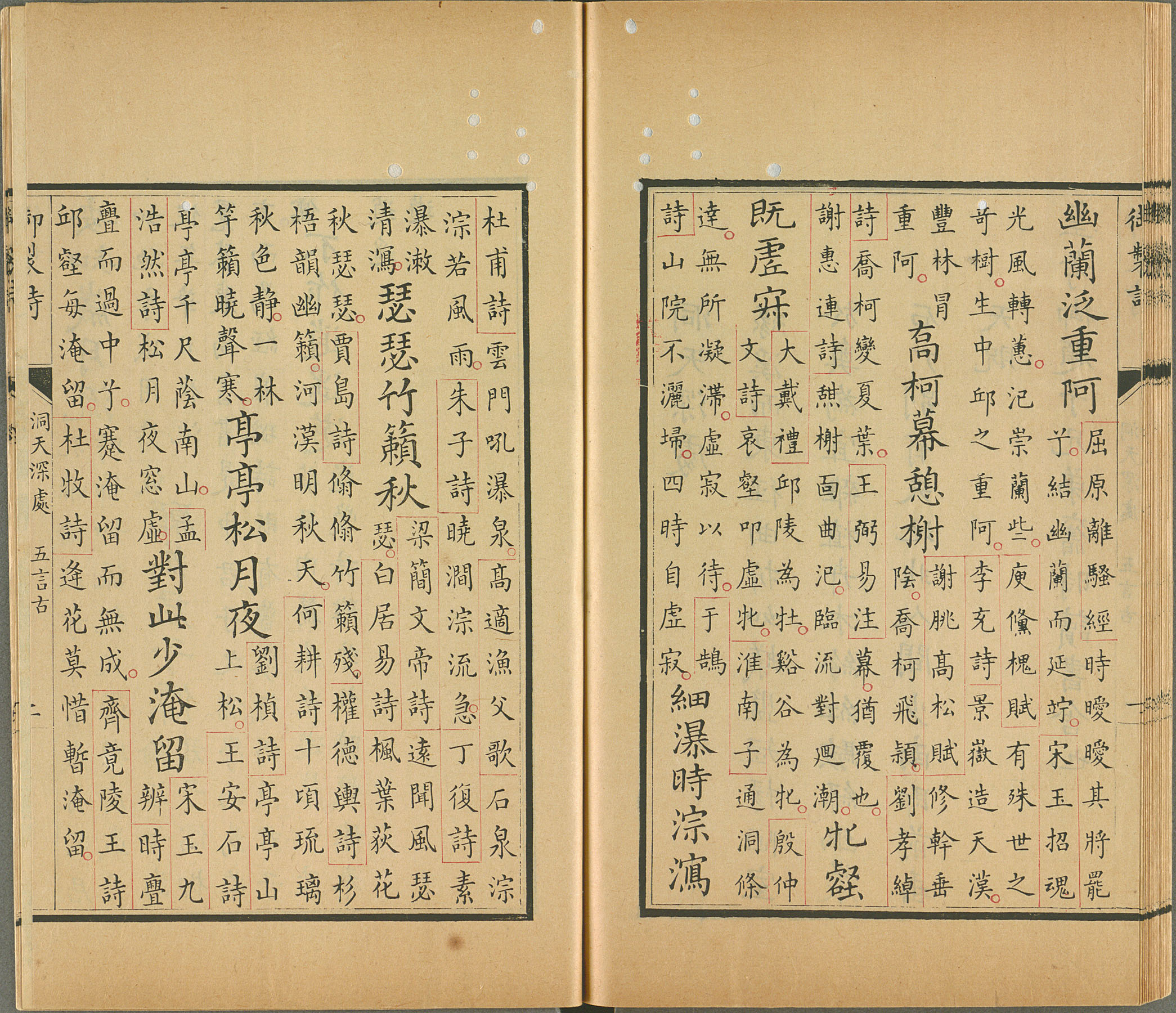
"Poems of Forty Scenes of Yuanmingyuan Made by the Imperial Palace" (Deep in the Cave Sky), Volume II, Volume II, Book of Martial Arts Palace, Qing Dynasty, Qianlong Year, Zhu Mo print, collected by the National Palace Museum, Taipei
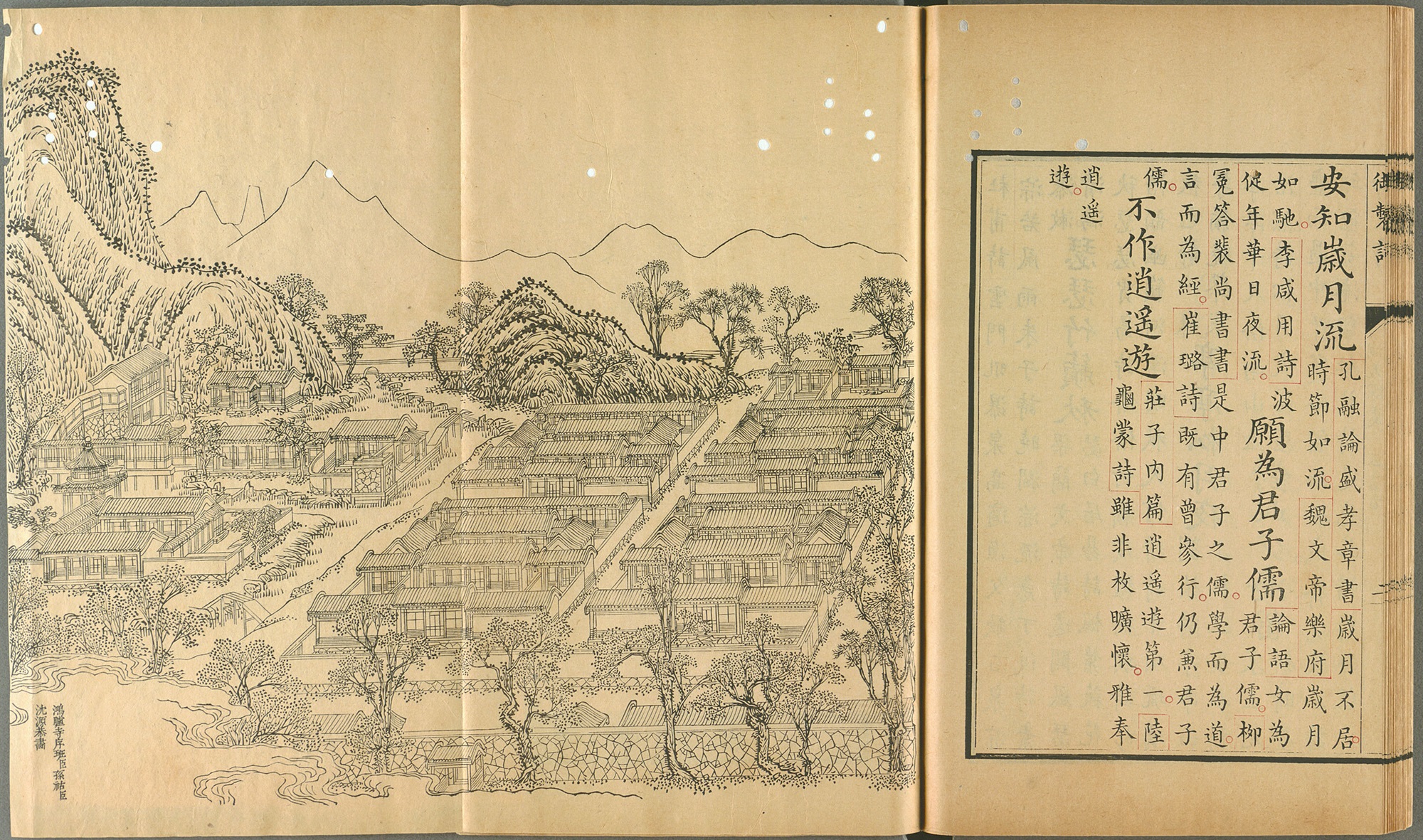
"Poems of Forty Scenes of Yuanmingyuan Made by the Imperial Palace" (Deep in the Cave Sky), Volume II, Volume II, Book of Martial Arts Palace, Qing Dynasty, Qianlong Year, Zhu Mo print, collected by the National Palace Museum, Taipei
Deep in the cave, one of the forty scenic spots of the Old Summer Palace, is located in the Fuyuan Gate of the Gongmen District of the Old Summer Palace. Emperor Qianlong recalled that "the old reading room for brothers is also". During the Yongzheng period, when the emperor lived in the Old Summer Palace, this place was where elder brother studied, so it is called the Upper Study Room in the Old Summer Palace.

"Poems of Forty Scenes of the Old Summer Palace Made by the Imperial Palace" (Luoyue Kaiyun) Volume 1, Volume 1, Qing Dynasty Qianlong Years, Wuying Palace Journal Zhumo print, Taipei Palace Museum Collection
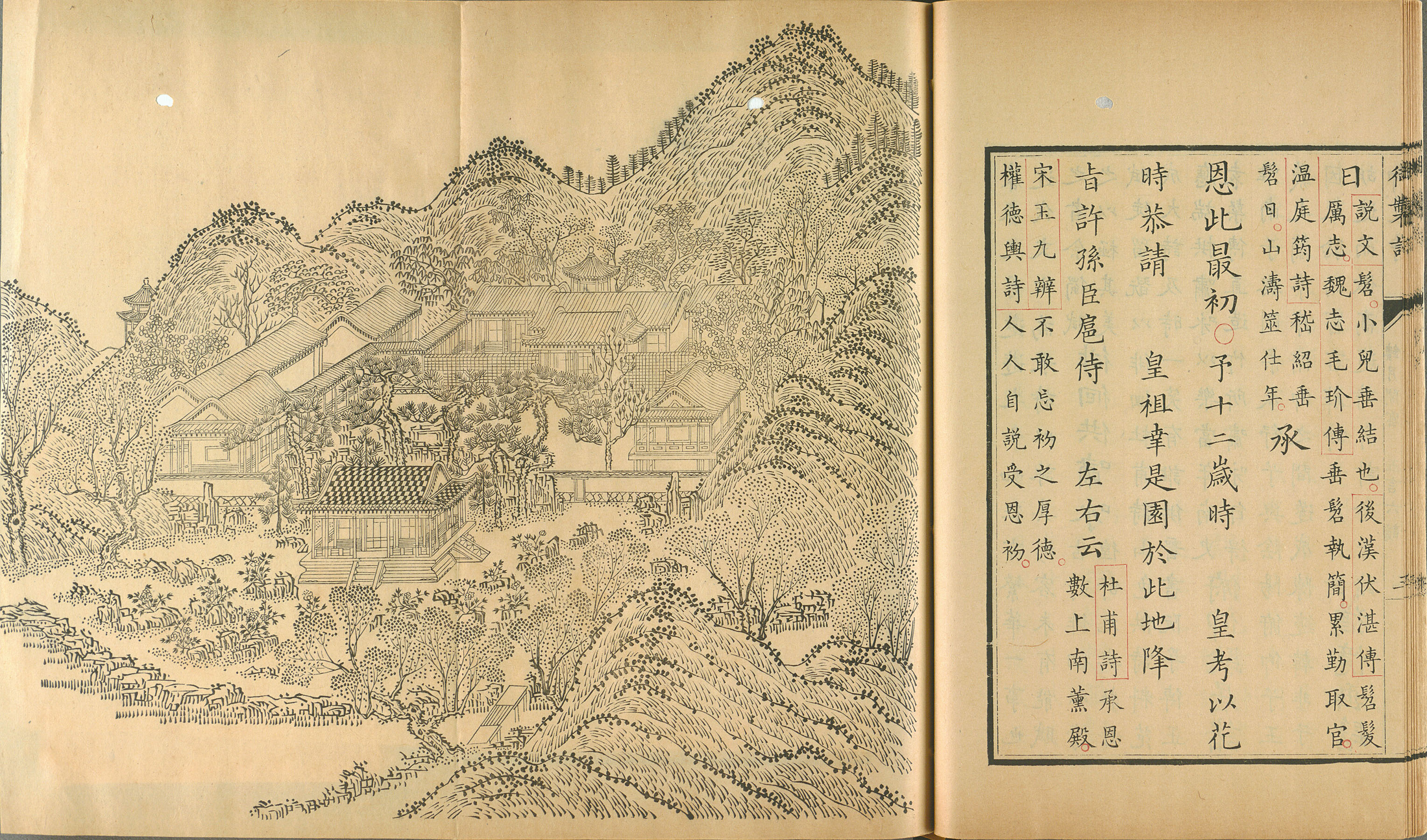
"Poems of Forty Scenes of the Old Summer Palace Made by the Imperial Palace" (Luoyue Kaiyun) Volume 1, Volume 1, Qing Dynasty Qianlong Years, Wuying Palace Journal Zhumo print, Taipei Palace Museum Collection
Opening the moon and opening the clouds, that is, the Peony Terrace in the Old Summer Palace where Qianlong met Emperor Kangxi for the first time at the age of 12. The Old Summer Palace was expanded by Emperor Yongzheng and Emperor Qianlong, and was roughly completed in the ninth year of Qianlong (1744). Emperor Qianlong imitated the thirty-six scenes of his ancestor Kangxi's summer resort, and also took forty scenes for the Old Summer Palace, and wrote poems himself. The Peony Terrace was renamed "Lou Yue Kai Yun".
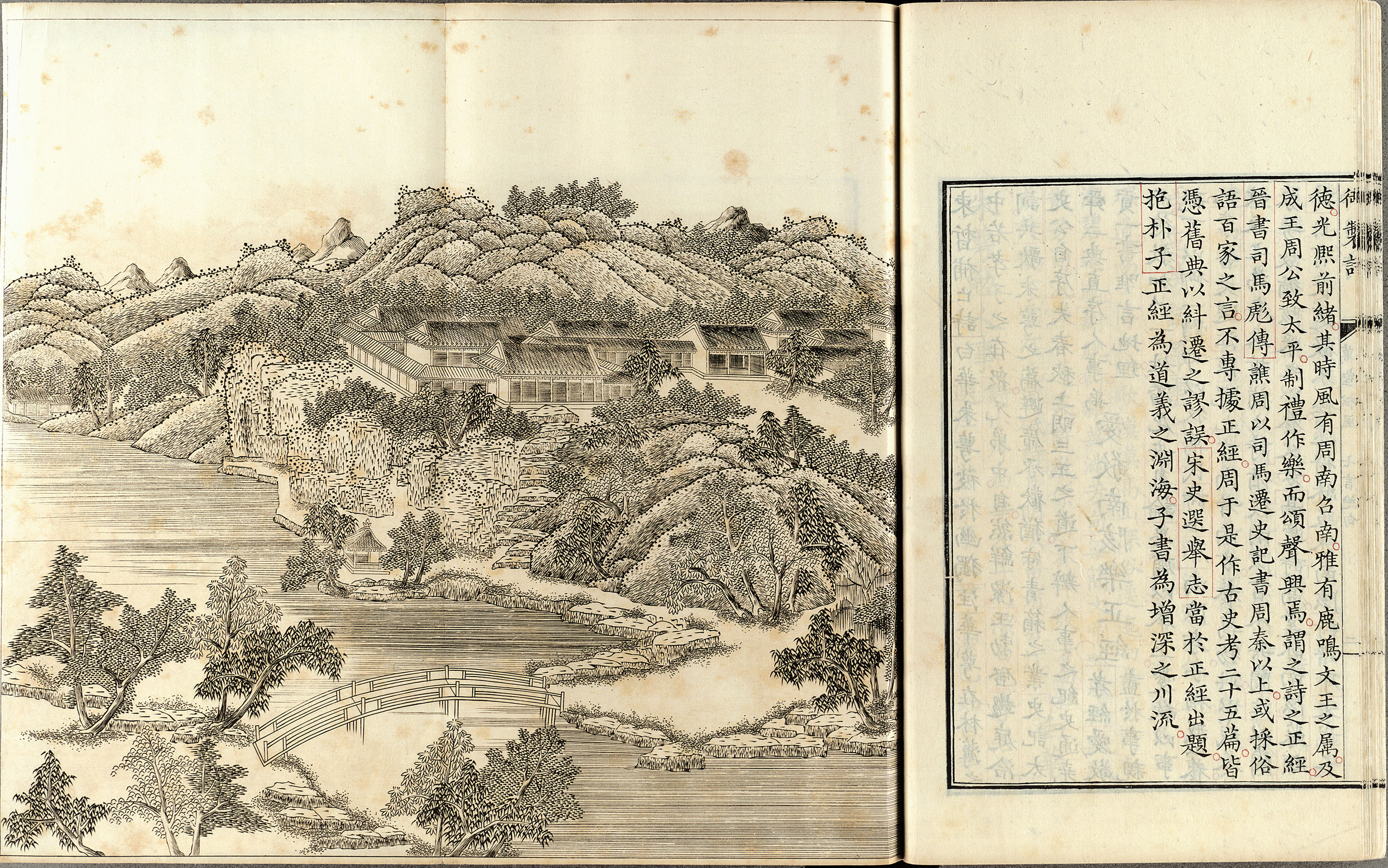
"Imperial Summer Resort Poems" (Pine Wind in Wanhe) Zhu ink copy of the Wuying Palace Magazine in the 51st year of Emperor Kangxi of the Qing Dynasty, collected by the National Palace Museum, Taipei
At a young age, Hongli accompanied Emperor Kangxi to the Summer Resort, and arranged to study at the "Wanhe Pine Wind" in the palace area of the villa, where he received day and night teachings from his imperial grandfather. In the 31st year of Qianlong's reign (1766), in order to express gratitude for his grandfather's upbringing, he renamed both the Old Summer Palace and the Summer Resort "Ji'en Hall" at the same time.
Brother's homework schedule
The content of the studies for the princes of the Qing Dynasty royal family required both civil and military skills. In terms of liberal arts, just like civilian students, they read the Confucian classics that were required for the imperial examinations, and learned to write poems, compose rhymes, and write policy essays and essays. Calligraphy, painting and literature are also compulsory courses for my brother, but the focus is on the creation of calligraphy and painting, unlike students who take scientific examinations who focus on calligraphy in the "Guange style".
Manchu and Mongolian languages in the Qing Dynasty were compulsory courses for brothers, and comparing them to modern times was like learning the local dialect. Riding and shooting martial arts are the core courses of the brothers. Through hunting training activities, they exercise fitness and cultivate courage and courageous attitude. The physical training part is closer to modern physical education classes. At that time, people in the Qing Dynasty only needed to learn different languages and engage in physical or martial arts training if they were to take the translation or martial arts exams.
Influenced by the spread of Western learning to the east, Emperor Kangxi issued trainings and Emperor Yongzheng respectfully recorded the "Tingxun Motto", urging his elder brother to also know astronomy and geography, and to pay attention to Western sciences such as calendars, mathematics, and music. Some of the natural science courses that the Qing court began to learn at that time are still basic courses for students today.
Course Contents
Brother’s teaching content can be summarized as follows: 1. The Four Books and Five Classics of Chinese culture, Confucian classics such as "Historical Records", "Hanshu" and "Zi Zhi Tong Jian"; 2. Poetry and prose; 3. Manchu and Mongolian language; 4. , riding and shooting martial arts; 5. practicing calligraphy; 6. Western sciences such as astronomy, calendar, mathematics and music.

"The Imperial Clan Instructions of the Jiaqing Emperor of the Qing Dynasty" Volume (part), the 13th year of the Jiaqing reign of Emperor Renzong of the Qing Dynasty (1808), collected by the National Palace Museum in Taipei

"The Imperial Clan Instructions of the Jiaqing Emperor of the Qing Dynasty" Volume (part), the 13th year of the Jiaqing reign of Emperor Renzong of the Qing Dynasty (1808), collected by the National Palace Museum in Taipei
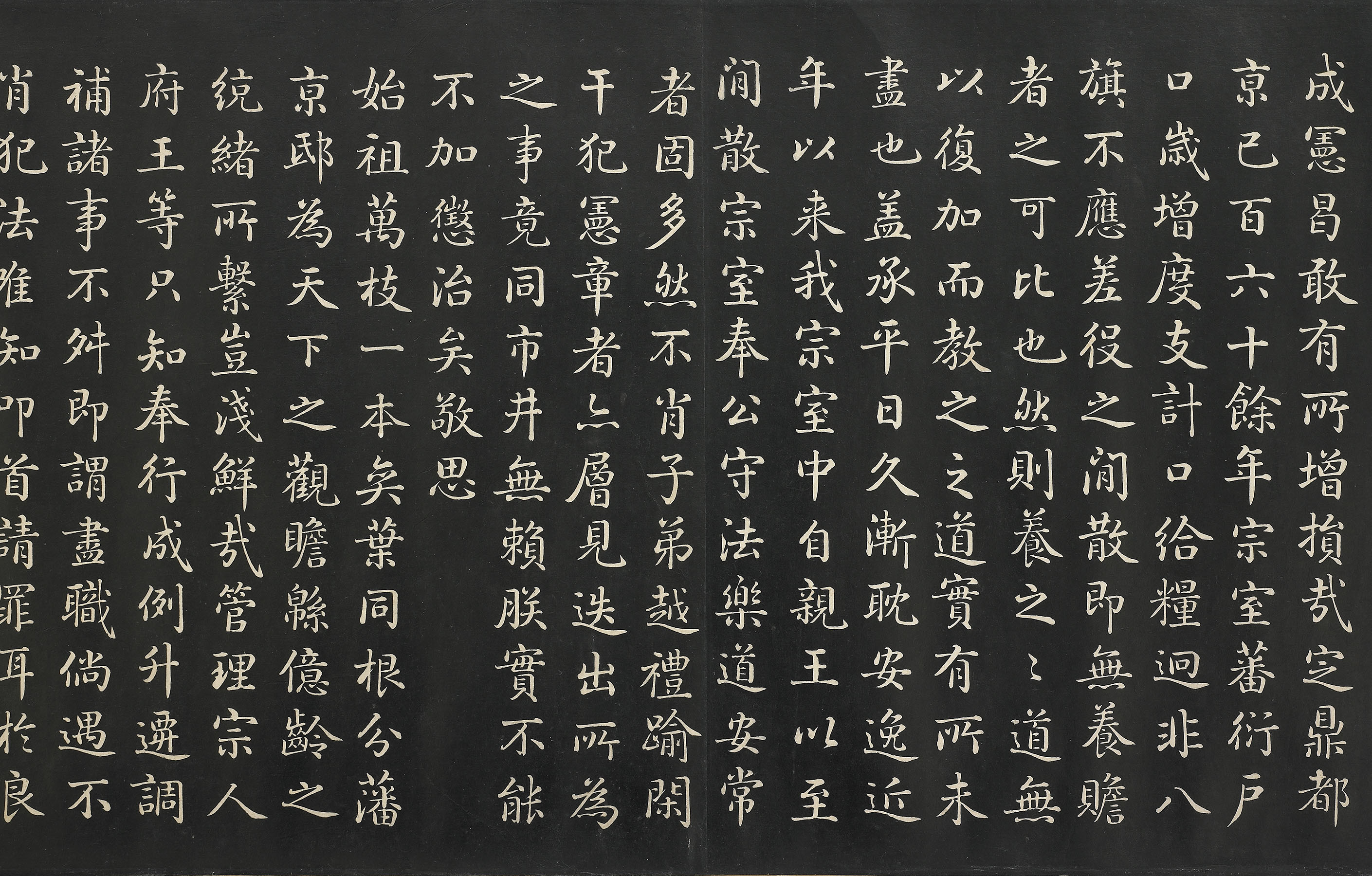
"The Imperial Clan Instructions of the Jiaqing Emperor of the Qing Dynasty" Volume (part), the 13th year of the Jiaqing reign of Emperor Renzong of the Qing Dynasty (1808), collected by the National Palace Museum in Taipei

"The Imperial Clan Instructions of the Jiaqing Emperor of the Qing Dynasty" Volume (part), the 13th year of the Jiaqing reign of Emperor Renzong of the Qing Dynasty (1808), collected by the National Palace Museum in Taipei
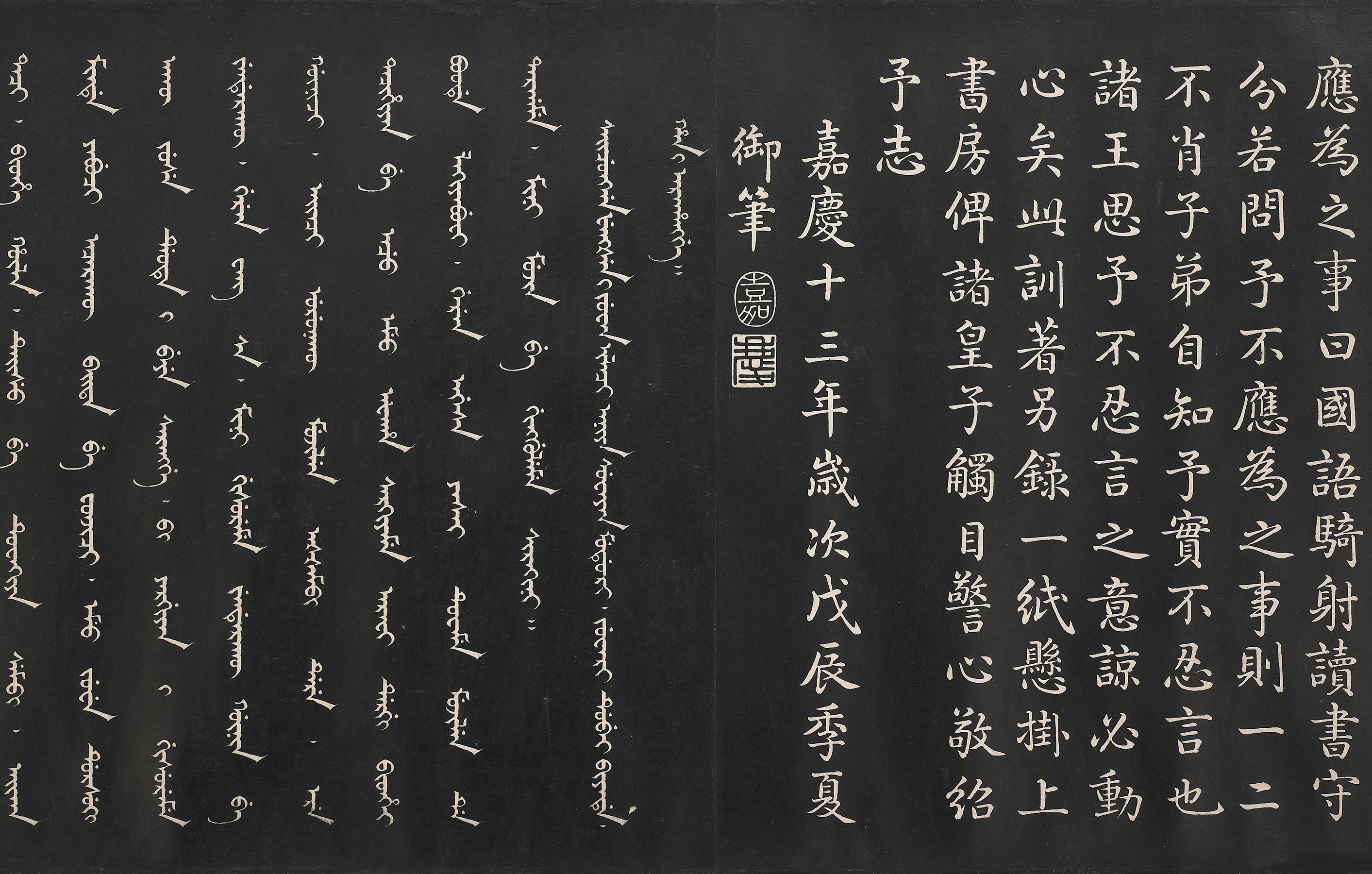
"The Imperial Clan Instructions of the Jiaqing Emperor of the Qing Dynasty" Volume (part), the 13th year of the Jiaqing reign of Emperor Renzong of the Qing Dynasty (1808), collected by the National Palace Museum in Taipei
Language learning is the primary content of my brother's study, especially Manchurian and Mongolian languages are the most important. The Qing Dynasty was an era of multi-ethnic exchanges. The Manchu rulers repeatedly emphasized that they must abide by the ancestral precepts and must maintain the Manchurian national characteristics of "Mandarin riding and shooting". In the early years of Shunzhi, he founded flag school to train Manchu children to learn Manchu and horse riding and archery. Emperor Kangxi was afraid that "younger generations will gradually learn Chinese and forget Manchu." Emperor Jiaqing also had this worry. In the 13th year of Jiaqing (1808), he wrote The "Imperial Clan Instructions" says: "Riding and shooting in Mandarin, and studying to keep the rules", and "record a separate piece of paper and hang it in the study room", so that the princes will be vigilant after seeing the instructions, and hope that the princes will respect and abide by the ancestral precepts.

"The Motto of the Holy Ancestor's Ting Xun" issued by the Holy Ancestor Kangxi; Shizong Yongzheng recorded "The Motto of the Holy Ancestor's Ting Xun" published by the Hall of Martial Arts in the eighth year of Emperor Yongzheng's reign in the Qing Dynasty, collected by the National Palace Museum in Taipei

"The Motto of the Holy Ancestor's Ting Xun" issued by the Holy Ancestor Kangxi; Shizong Yongzheng recorded "The Motto of the Holy Ancestor's Ting Xun" published by the Hall of Martial Arts in the eighth year of Emperor Yongzheng's reign in the Qing Dynasty, collected by the National Palace Museum in Taipei
Riding and archery martial arts is a Manchu tradition, and the proficiency of riding and archery skills depends on the proficiency of horse riding skills. The brothers have all learned bow-drawing, foot-shooting and horse-mounted archery courses since childhood. Generally, the horse-riding and archery courses are arranged after reciting scriptures, interspersed with courses of studying Chinese classics. The Holy Ancestor Kangxi's riding and archery skills were very outstanding. He mentioned in "Tingxun Motto": "The art of riding and shooting must be practiced since childhood to become proficient. There is no one who is not good at riding a horse but can be good at riding and shooting. Therefore , the royal family of the Qing Dynasty attached great importance to the riding and archery training of the brothers, and they must learn it from an early age in order to achieve the level of "people and horses can get along well with each other, fly up and down, control the chime to chase birds, and hit the target with certainty, which is refreshing to watch." .

"The Veritable Records of Emperor Gaozong of the Great Qing Dynasty" compiled by Qing Qinggui and others under the imperial edict of the Qing Emperor Qianlong in August of the fifty-sixth year of the Qing Dynasty, the small red silk edition in Chinese, in the collection of the National Palace Museum in Taipei
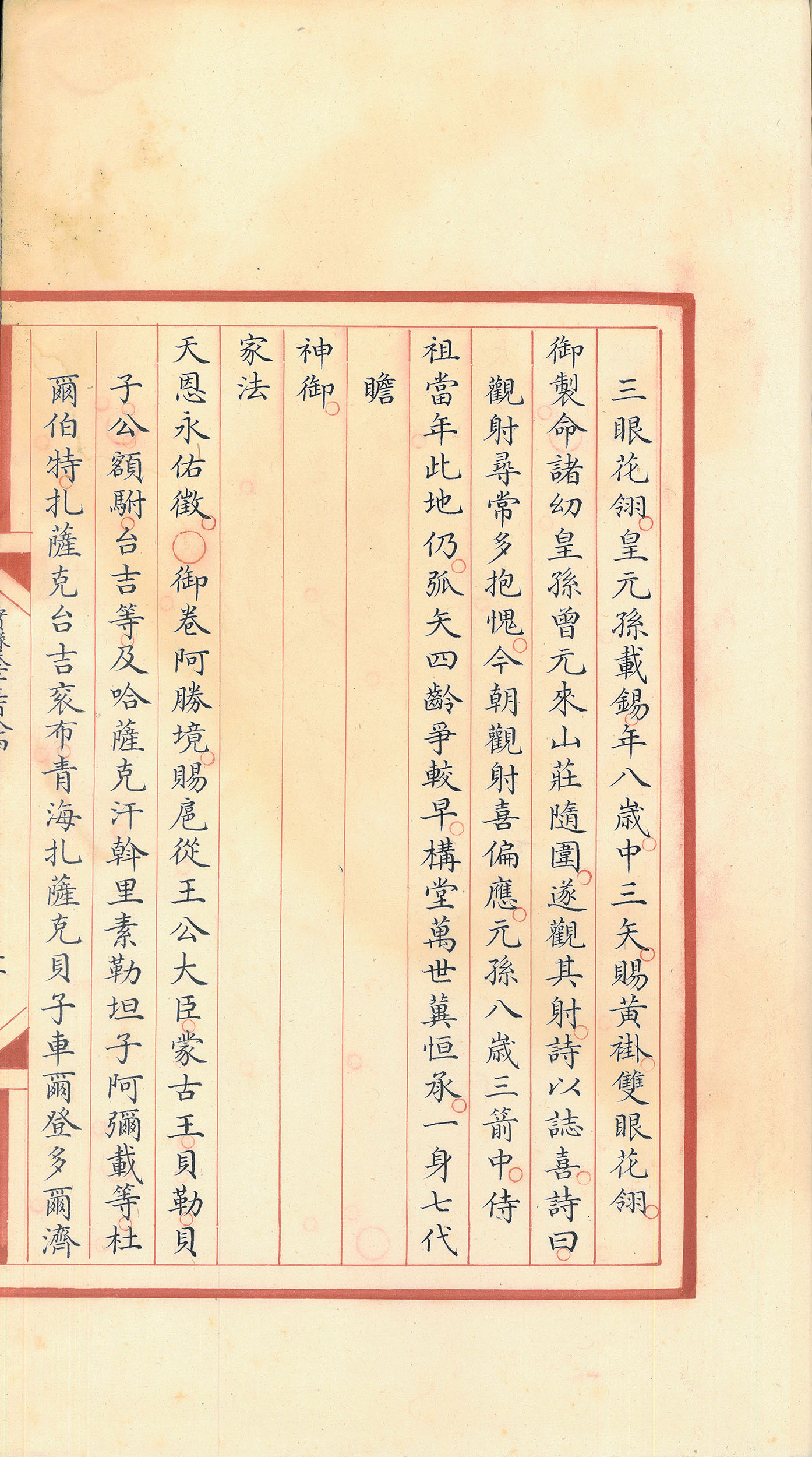
"The Veritable Records of Emperor Gaozong of the Great Qing Dynasty" compiled by Qing Qinggui and others under the imperial edict of the Qing Emperor Qianlong in August of the fifty-sixth year of the Qing Dynasty, the small red silk edition in Chinese, in the collection of the National Palace Museum in Taipei
The records of archery activities and walks of elder brothers can be found in documents such as "Records" and "Life Registration" of various dynasties, and can also be found in poetry collections. On August 12th in the fifty-sixth year of Qianlong (1791), there was an archery event at the Summer Resort. Qianlong watched the emperor's grandsons shoot arrows. The emperor's grandson Mianqing (1779-1804), who was thirteen years old, shot three arrows and was awarded a yellow coat with three eyes and feathers. The emperor's great-great-grandson Zaixi, who was eight years old, also shot three arrows and was awarded a yellow coat with two eyes and feathers. Qianlong was extremely happy and wrote a poem about this event. He remembered that the emperor's great-great-grandson Zaixi was four years younger than when he accompanied the emperor Kangxi on the hunt. This legacy has been passed down for seven generations.

"Song Tuo Duo Bao Pagoda Stele" Calligraphy Practice "Song Tuo Duo Bao Pagoda Stele" booklet with paper clips, National Palace Museum, Taipei
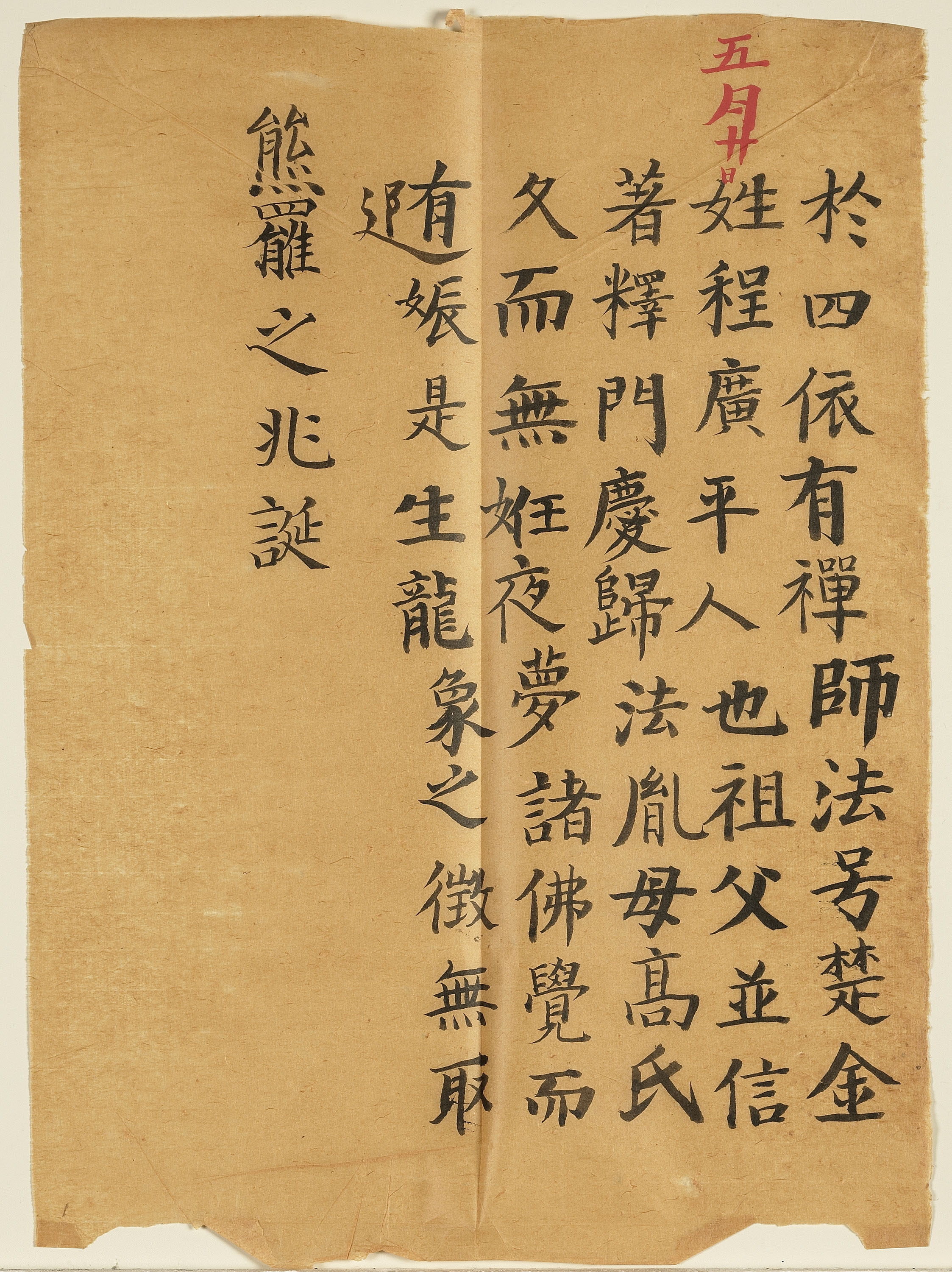
"Song Tuo Duo Bao Pagoda Stele" Calligraphy Practice "Song Tuo Duo Bao Pagoda Stele" booklet with paper clips, National Palace Museum, Taipei

"Song Tuo Duo Bao Pagoda Stele" Calligraphy Practice "Song Tuo Duo Bao Pagoda Stele" booklet with paper clips, National Palace Museum, Taipei
Calligraphy practice is a must for brothers every day. Taking Emperor Qianlong as an example, when he entered the palace to study in the 61st year of Kangxi (1722), he copied Tang regular script, such as "Duobao Pagoda Stele" by Yan Zhenqing (709-785). The exhibited "Duobao Pagoda Stele" study is sandwiched behind the rubbing. It was corrected with a Chinese ink pen and signed to copy the date, which is a typical example of the master in the palace teaching elder brother to practice calligraphy. Another calligraphy exercise in "Duobao Pagoda Stele" is no longer a copybook, but has the meaning of free creation and writing, and the handwriting is elegant and elegant.
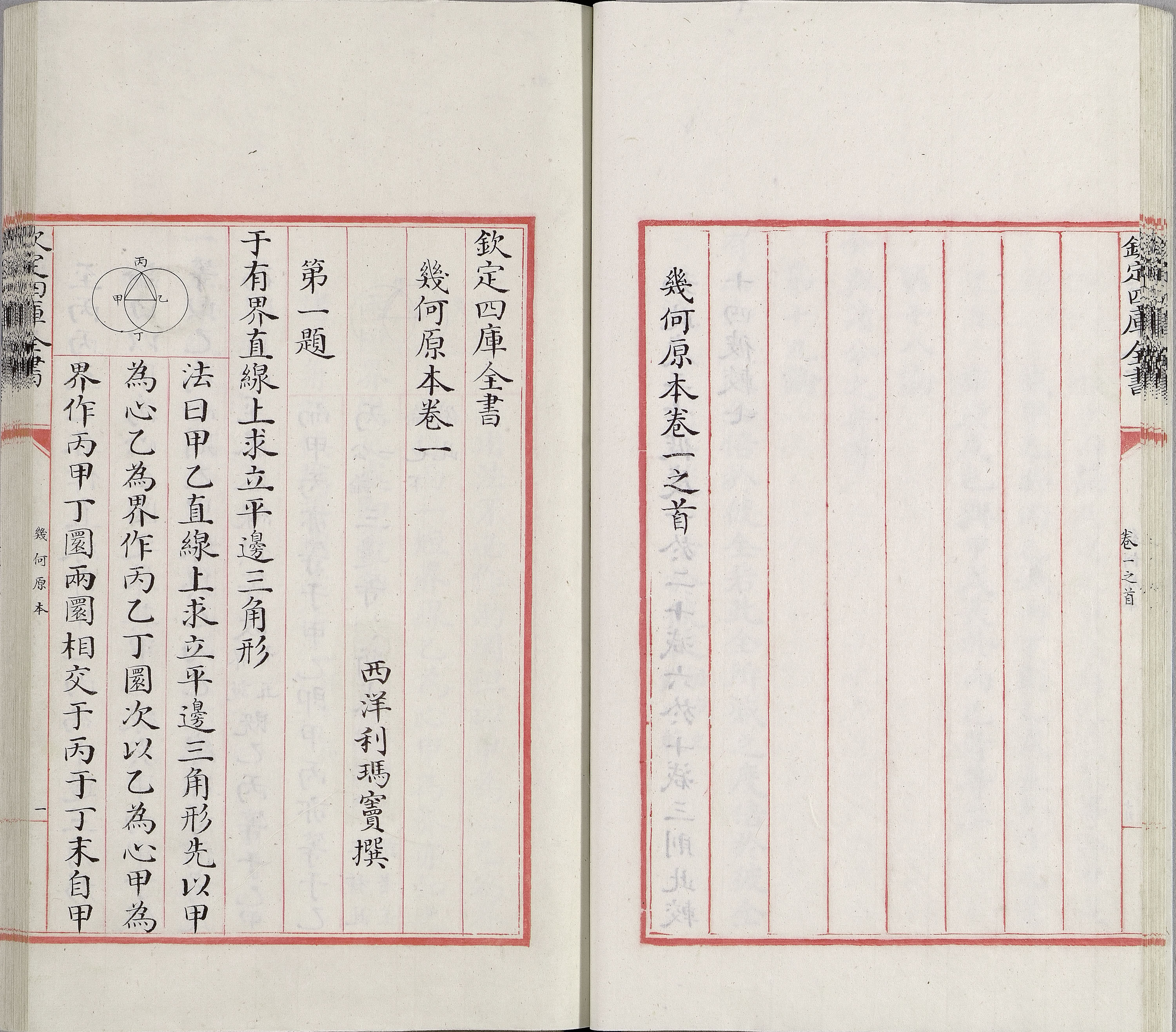
"Geometry Elements" six volumes (Western) written by Euclid, written during the Qianlong period of the Qing Dynasty, the complete book of the Siku of Wenyuan Pavilion is collected by the National Palace Museum, Taipei
Emperor Kangxi learned mathematics introduced from the West from missionaries such as Bai Jin (1656-1730) and Zhang Cheng (1654-1707) from France, Nan Huairen from Belgium (1623-1688), and De Lige from Italy (1671-1746). , astronomy, rhythm, medicine and other natural sciences. Emperor Kangxi was very interested in Western science and also introduced his brothers to Western learning. The book "Elements of Geometry" is on display, which was written by the ancient Greek Euclid, interpreted by the Italian Matteo Ricci (1552-1610), and written by Xu Guangqi (1562-1633) of the Ming Dynasty. According to the French missionary Bai Jin's "Biography of Emperor Kangxi", he described how Emperor Kangxi learned geometry. He first ordered the missionaries to teach in Manchu, and ordered two ministers who were proficient in Manchu and Chinese to write lectures. They listened to the lectures repeatedly, reviewed them, and personally In drawing, you will be proficient in geometric principles in about five or six months.
royal textbook
Books such as "Emperor's Illustrated Commentary" and "Yangzheng Illustrated Interpretation", which were drawn or reprinted by the Qing Dynasty in the courtyard's collection, use vivid illustrations to teach my elder brother about the governance deeds of ancient Chinese emperors. According to the "Daily Registration" in October of the 11th year of Xianfeng (1861), "Emperor's Pictures and Pictures" was listed as an important study material for the young emperor Tongzhi. Later, the story was narrated by two imperial teachers, Qi Jianzao and Weng Tonghe. In addition, Emperor Qianlong ordered Yongxuan (1739-1777), Yongxuan (1752-1823), Yongrong (1744-1790) and the emperor's grandson Mianning (the Emperor Daoguang, 1782-1850) to copy the "Emperor Study" written by Fan Zuyu of the Song Dynasty. "This book. This book is a history textbook dedicated to teaching the virtuous monarchs of the past dynasties, setting an example for self-cultivation, and continuing their studies. Through the process of copying, brothers can learn the necessary virtues to become wise kings.

"Emperor Studies" Mianning Zhu Silan Note Pocket Edition from the Jiaqing Period of the Qing Dynasty Collection of the National Palace Museum in Taipei

"Emperor's Illustrations" Undivided Volume (Volume 2) (Edict Confucian Lectures) Qing Dynasty Illustrated Edition Collection of the National Palace Museum in Taipei
"Challenging Confucians to Lecture on the Classics" tells the story that Emperor Xuan of the Han Dynasty (91-49 BC) ordered Confucian scholars to publish the Five Classics (i.e., the Book of Songs, the Book of Documents, the Book of Rites, the Book of Changes, and the Spring and Autumn Annals), and also ordered the prince Taifu Xiao Wangzhi (BC? -46) Commentary, so that the scriptures tend to be unified and become the standards for governing the world. The Qing Dynasty followed the tradition of Chinese emperors. Emperor Shunzhi initiated the practice of Sutra banquets and daily lectures. By imitating the national ceremony of the Ming Dynasty, lecture officials compiled sermons, demonstrating the emperor's basic national policy of advocating Confucian governance.
Brother’s teachers
Those who taught the elder brothers included the chief master, the master, and Shuda, as well as several accompanying and reading companions. Shuida (Manchu transliteration: anda) means partner and friend. He is responsible for teaching Manchu and Mongolian Chinese and riding and archery to his brothers. The emperor and the elder brother paid great attention to the etiquette of the master in the study. According to the records of the Qing Dynasty's "Bamboo Window Notes": When they first arrived in the study, the elder brother and the master bowed their hands to each other and saluted each other. Every day, the elder brothers and the master held hands as a gesture of full respect. meaning.
Because my brother was enrolled in school, he had known his master day and night for many years, and the friendship between teacher and student was profound. Even if he ascends the throne and becomes emperor in the future, he will still miss the years and scenes of getting along with his master and Shuda as a tutor. For example, Emperor Qianlong had many famous teachers at his residence, including Fu Min (1673-1756), Zhu Shi (1665-1737) and Cai Shiyuan (1681-1734), who were later known as the "Three Masters". I have constant gratitude throughout my life, and it is often expressed in my poems and works.

"Records of Emperor Gaozong Chun of the Qing Dynasty", Volume 1,324, March 54, Qianlong, collected by the National Palace Museum, Taipei
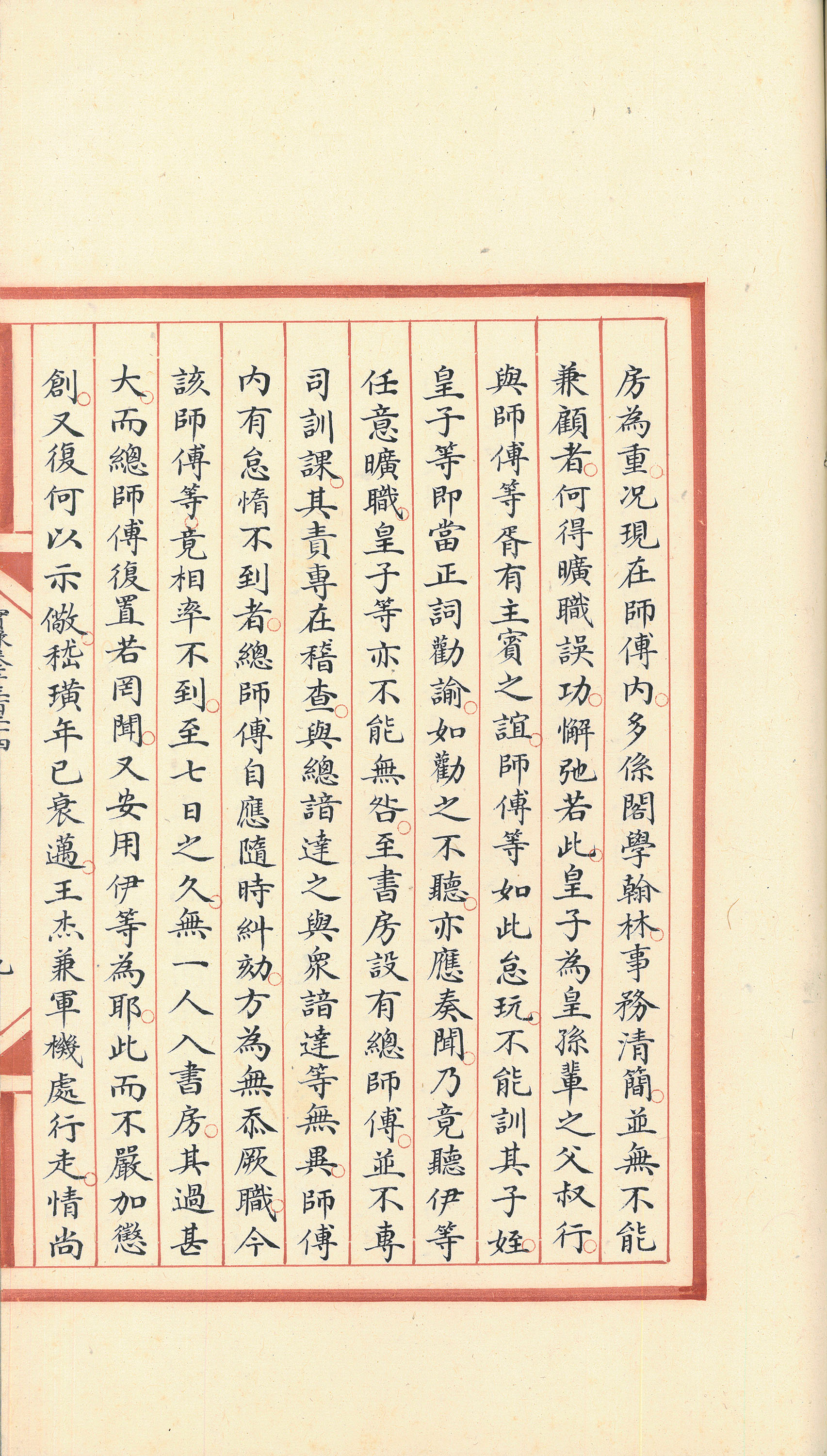
"Records of Emperor Gaozong Chun of the Qing Dynasty", Volume 1,324, March 54, Qianlong, collected by the National Palace Museum, Taipei

"Records of Emperor Gaozong Chun of the Qing Dynasty", Volume 1,324, March 54, Qianlong, collected by the National Palace Museum, Taipei
In the Qing Dynasty, only well-educated scholars with excellent academic backgrounds could serve, even if they were not from the Imperial Academy, or at least from the Jinshi family. Moreover, they were all emperor's special papers. The exhibits include Ji Huang, Wang Jie, Pan Shien, Mu Zhang'a, Weng Tonghe, Li Hongzao and others who served as the chief masters of the study room. One of them, "Records of Emperor Gaozong", records that "the master did not enter the study to discuss matters": In March of the 54th year of Qianlong's reign, for six consecutive days, no one from the chief master to the master entered the study, so they were all discussed. Got it. It can be seen from this incident that the emperor of the Qing Dynasty attached great importance to the study of his elder brothers.

"The Final Edition of the Complete Works of Weiyu Shoushi" "Original Preface to the Selected Poems and Essays of Weiyu Shoushi" written by Renzong of the Qing Dynasty; Qinggui and others were ordered to compile the final volume of "The Complete Works of Weiyu Shoushi" (Volume 1) by Wuyingdian in the sixth year of Jiaqing in the Qing Dynasty Publication, collected by the National Palace Museum, Taipei
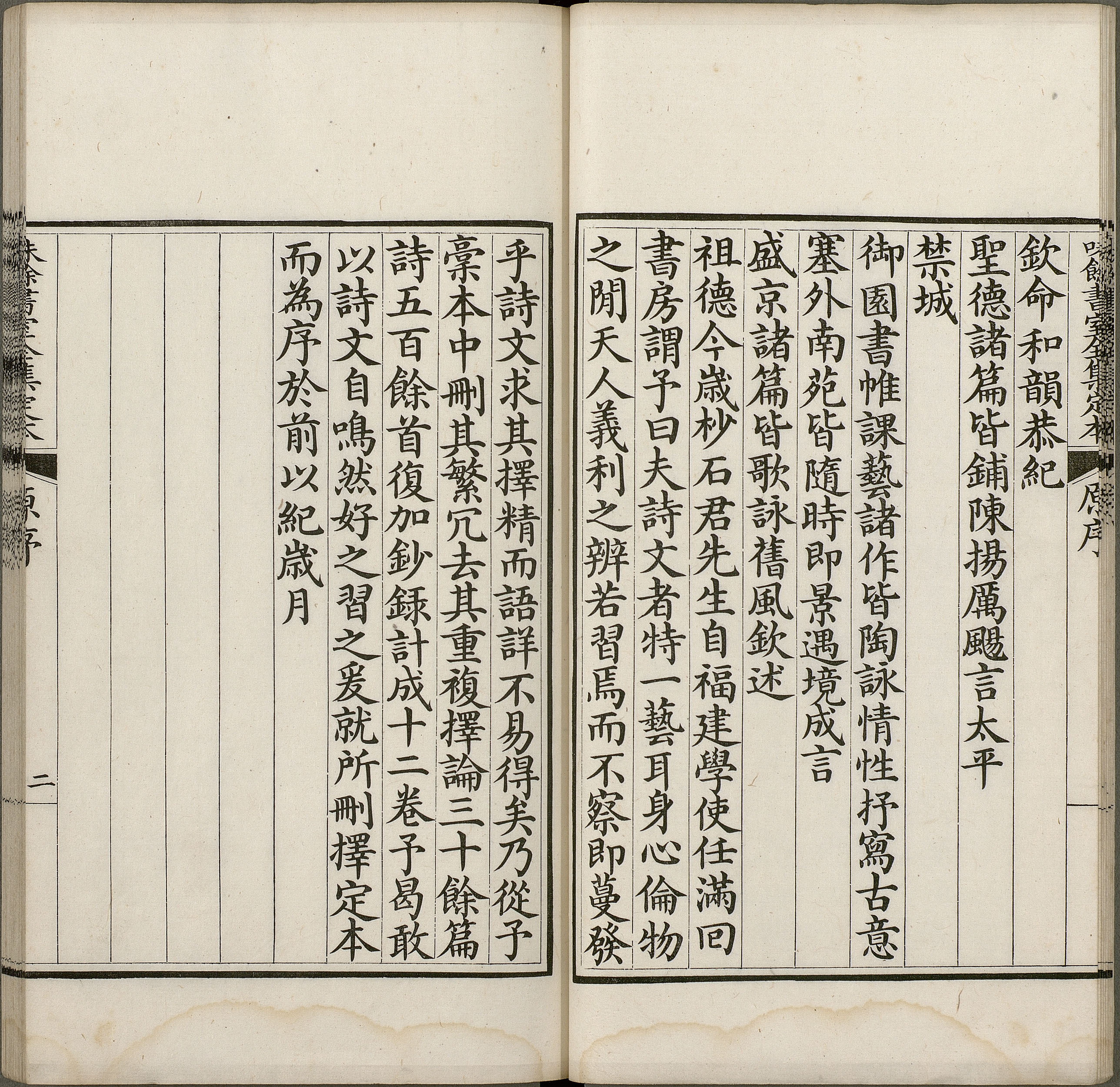
"The Final Edition of the Complete Works of Weiyu Shoushi" "Original Preface to the Selected Poems and Essays of Weiyu Shoushi" written by Renzong of the Qing Dynasty; Qinggui and others were ordered to compile the final volume of "The Complete Works of Weiyu Shoushi" (Volume 1) by Wuyingdian in the sixth year of Jiaqing in the Qing Dynasty Publication, collected by the National Palace Museum, Taipei
Emperor Jiaqing was located in the "Weiyu Study Room" in Yuqing Palace. He named his master Zhu Gui, saying that "there is more than enough for diligent scholars, and not enough for lazy ones. There is more than enough to taste." The "Original Preface" of "The Complete Works of Weiyu Bookstore" describes Jiaqing's schooling stage: "At the age of six, he studied classics, poetry and essays at the age of thirteen, and poetry at the age of seventeen. He first studied with Master Dongshu, and studied classical poetry and classical prose from Master Shi Jun." During the development stage of Emperor Jiaqing, Master Zhu Gui guided and accompanied him, especially in writing poems and reading ancient prose.

"Zou Baochen's Severe Sickness Looking to the Sky and No Sun (Remaining Book)" Du Shoutian, Qing Dynasty, Collection of Taipei Palace Museum

"Zou Baochen's Severe Sickness Looking to the Sky and No Sun (Remaining Book)" Du Shoutian, Qing Dynasty, Collection of Taipei Palace Museum
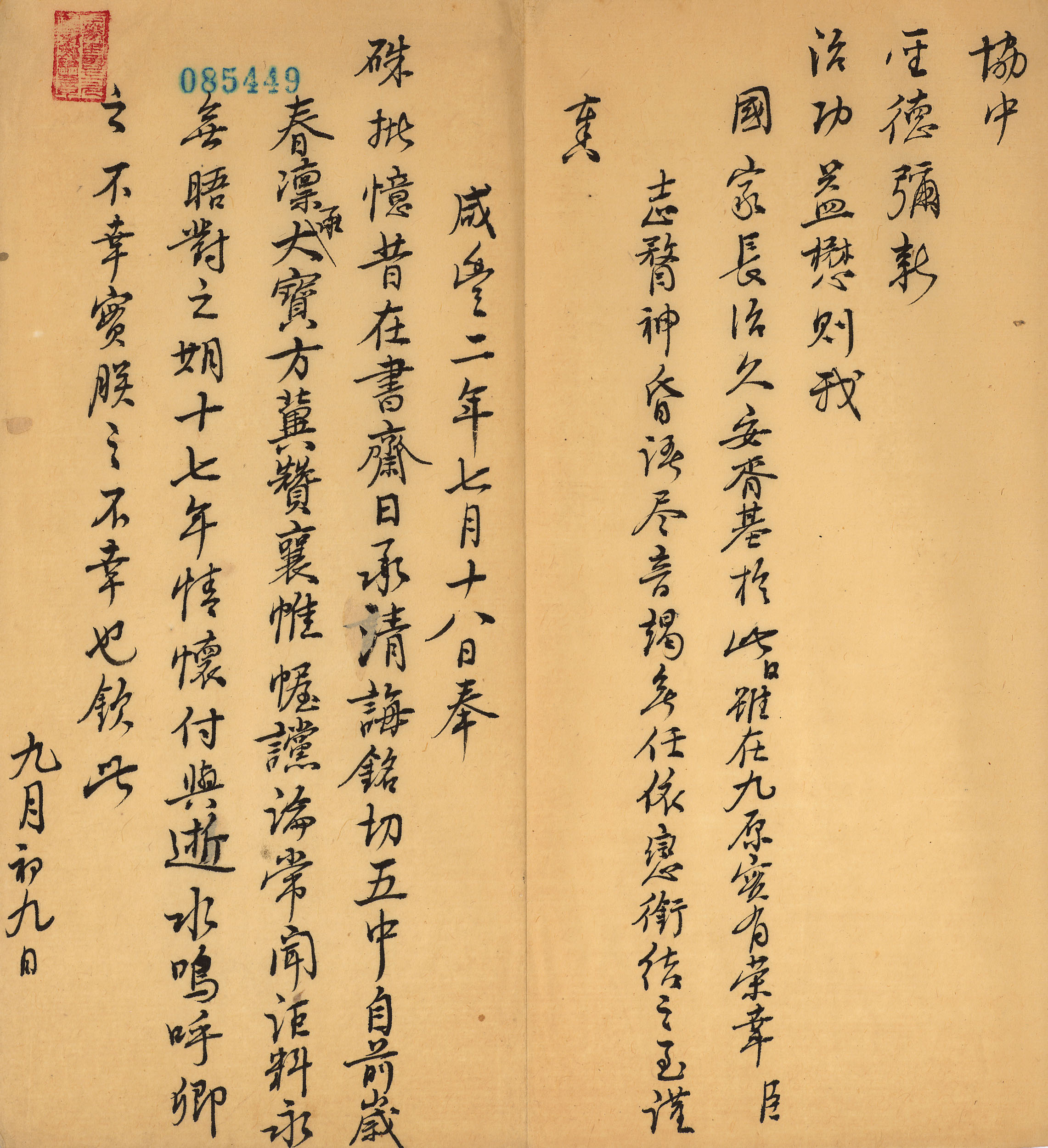
"Zou Baochen's Severe Sickness Looking to the Sky and No Sun (Remaining Book)" Du Shoutian, Qing Dynasty, Collection of Taipei Palace Museum
After Du Shoutian died of illness, Xianfeng wrote on the legacy of his master Du Shoutian: "Recalling the past in the study, I inherited the clear teachings every day, and remembered the five middle schools... The old materials will never meet again, and the seventeen years of feelings are lost. Woohoo! Your misfortune is really my misfortune." Master Yu's deep expectations for his disciples seem to be "gone with the passing water" with the passing of the master.

exhibition poster
The exhibition lasts until November 5th.
(The pictures and texts in this article are compiled according to the official website of the National Palace Museum in Taipei)
